2023-09-12
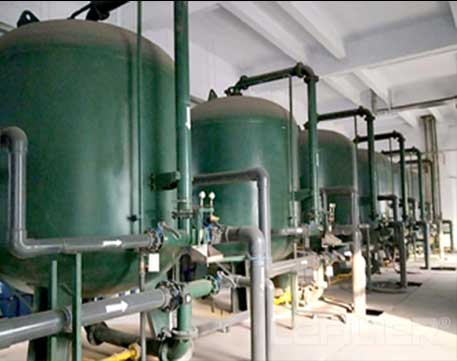
The multi-media filter uses quartz sand and anthracite as two filter materials to remove suspended solids in raw water. It is an ordinary rapid filtration equipment.
The water containing suspended solid particles is thoroughly mixed with the flocculant, so that the electric double layer forming colloidal particles in the water is compressed. When the colloidal particles flow through the filter material layer of the multi-media filter, the gaps in the filter material screen the suspended solids, making it easy for the suspended solids to be adsorbed on the surface of the filter material. When a certain amount of dirt is trapped on the surface of the filter material to form a filter membrane, the pressure difference between the front and rear of the filter will increase over time until it fails. At this time, it is necessary to use reverse flow of water to backwash the filter material to suspend and loosen the quartz sand and anthracite coal layers in the filter, so that the trapped matter adhered to the surface of the quartz sand and anthracite coal is peeled off and taken away by the water flow to restore the filtration function. The double-layer filter material used in this project is to place lighter large-grained anthracite coal on the upper part of the filtering layer and small-grained quartz sand with large specific gravity on the lower part. This can give full play to the efficiency of the entire filtering layer and improve the pollution interception capacity.
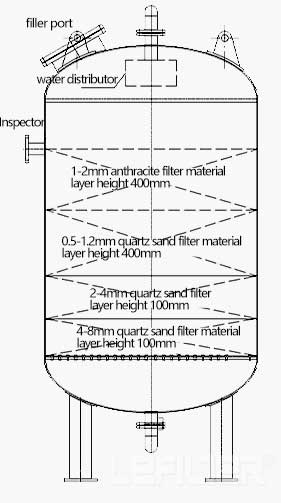
1. Daily operation inspection:
After entering normal production, operators must regularly inspect the equipment site every hour. Record the inspection results truthfully and summarize them together with the operation records as information for regular maintenance.
Inspection cycle Inspection items Inspection methods or inspection points
Check whether there is water leakage. Check whether there is water leakage in the sealing parts of the equipment and the attached valves. If there is water leakage, find out the location and cause of the leakage point and stop the leakage in time.
Check whether there is any vibration. Whether there is abnormal vibration when the valve is opened and closed. If there is vibration, find out the cause and take timely measures.
Check the flow rate once a month. Check the flow meter indication value to verify whether it indicates normal flow rate. If the flow rate indication is abnormal, find out the cause in time and eliminate the fault.
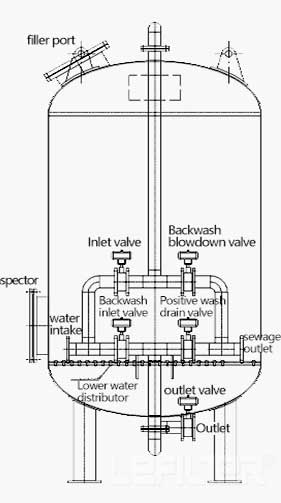
2. Regular inspection:
Equipment must be inspected regularly to ensure safe operation of the system over a longer period of time. This equipment is a relatively large one and the inspection operation will take a long time. In order to shorten the shutdown time for regular inspections, it should be carried out at the same time as possible with the maintenance of other equipment and devices of the raw water treatment device. If any abnormalities are found, they should be dealt with in time.
NO. Inspection items Inspection methods
1 Packing inspection Check the quartz sand anthracite filter material. If the quartz sand anthracite is seriously contaminated, all of it should be replaced.
2. Inspection of water filter cap
Take out the packing, rinse it with water, and check the water filter cap on the porous plate. If it is found to be damaged or loose, replace or fix it in time.
3 Rubber lining layer inspection
If bubbles, cracks, adhesive peeling, micropores, etc. are found in the rubber lining layer, they must be repaired.
4 Internal fastener inspection
Check the bolts, nuts and other fasteners in the filter. If they are loose, tighten them.
5 Manhole gasket inspection
Replace the deformed manhole gasket; soak the bolts and nuts in cleaning oil to thoroughly remove rust; apply butter to the bolts and nuts when installing the manhole cover.
3. Filter material replacement:
NO. Operating steps Operating method
1 Drainage Drain the accumulated water inside the filter
2 Discharge: Open the filter discharge port, add a small amount of water from the backwash port, and flush out the filler.
3 Cleaning: Drain the accumulated water in the filter, open the upper manhole, enter the filter, and clean the remaining filter material out of the filter.
4 Cleaning Use a rag to clean the inside of the filter.
5. Fill filter media
Close the discharge port, fill the filter material according to the specified height, first install quartz sand, level it after loading, and then install anthracite coal.
6. Close the filter. Check that the filling height of the filter material meets the requirements and close the upper manhole.
7 Rinse the filter material. Follow the filter backwashing steps to rinse the filter material until the drainage turbidity is less than 1 degree.
Filter material:
(1) Anthracite (upper layer): particle size: 0.8-1.2mm; thickness: 400mm
(2) Quartz sand (lower layer): particle size: 0.4-0.65mm; thickness: 800mm
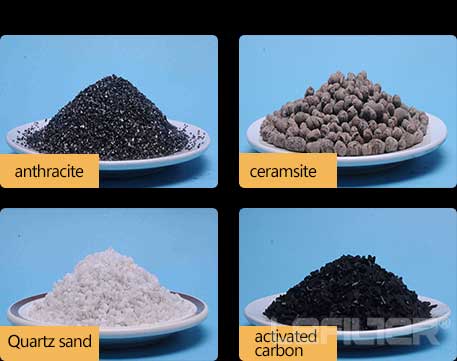
4 General operating steps for multi-media filters:
1. Equipment for water production:
1.1 Positive washing (1)
Open the wash drain valve MV116.
Open the water inlet valve MV111.
The normal washing is qualified when it lasts for 3 minutes or the effluent turbidity is less than 1NTU.
1.2 Water production
Open the water outlet valve MV112.
Close the wash drain valve MV116.
Start making water.
System operation inspection.
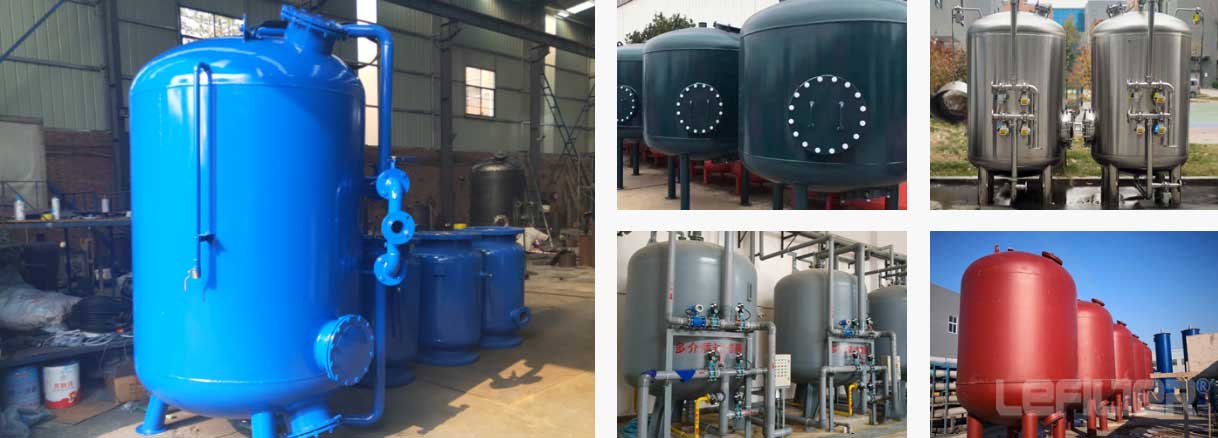
2. Equipment backwash:
2.1 Loose filter material
Check whether the liquid level in the backwash water tank is at a high level and must meet the filter backwash water volume requirements.
Open the backwash drain valve MV114
Start the backwash pump P102.
Open the backwash water inlet valve MV113 and backwash for 5 minutes.
2.2 Drainage
Close the backwash water inlet valve MV113.
Turn off the backwash pump P102.
Open the positive exhaust valve MV116 and the exhaust valve MV117.
Drain until the filter liquid level reaches the middle of the upper sight glass (drainage time is 10 minutes).
2..3 Air scrubbing
Close the positive exhaust valve MV116.
Open the intake valve MV115.
Air scrubbing time is 3-5 minutes.
2.4 Water backwash
Close the intake valve MV115 and exhaust valve MV117.
Start the backwash pump P102.
Open the backwash water inlet valve MV113 and backwash for 10-15 minutes.
2.5 Let stand
Close the backwash water inlet valve MV113.
Turn off the backwash pump P102.
Let sit for 3 minutes.
2.6 Regular washing (2)
Close the backwash drain valve MV114.
Open the water inlet valve MV111 and the lower drain valve MV116.
The normal washing is qualified when the washing time is 30 minutes or the effluent turbidity is less than 1NTU.
The device goes into standby state.
3. Device switching:
When the running time of a multi-media filter reaches the cumulative running time of backwashing, the filter will be backwashed in the order of "2. Equipment Backwashing". After the backwashing is completed, it will enter the standby state. At the same time, the original standby filter will be put into operation. run.
5. Operation instructions:
The operation, forward and backwashing of the multi-media filter in this device are all automatic operations. During trial operation or after formal operation, the following adjustments should be made:
Processing capacity:
Designed processing flow: 27m3/h, design flow rate 5.5m/h.
Continuous running time:
The system is designed to run for 24 hours, and then the multi-media filter should be backwashed; the backwash cycle should be adjusted according to seasons, changes in water quality, etc. to ensure that the effluent turbidity is less than 1 degree. When the pressure difference between the inlet and outlet of the multi-media filter reaches 0.03 MPa, it should be backwashed.
Backwash flow:
The purpose of backwashing is to reversely loosen the quartz sand and anthracite coal, and wash away the trapped material on the filter layer to clean the filter layer. The backwash flow rate is usually controlled at about 30 m/s, so that the anthracite coal is not It is better to rush and run.
Backwash time:
The length of backwashing time is related to the amount of dirt intercepted by the packing layer. The backwash time can be determined according to the backwash drainage turbidity. Under normal circumstances, the backwash turbidity should be less than 1NTU, that is, 1 degree, and the time should be no less than 5 minutes. It can be adjusted appropriately according to the operating conditions.
Positive wash flow:
The forward washing flow rate can be around 25m3/h.
Main washing time:
The turbidity of the water after washing is about 1 degree, and the washing time usually lasts about 30 minutes.
Addition of quartz sand and anthracite:
Due to running friction and backwashing, the filler layer will gradually decrease. Monitor the changes in the filler through the observation hole. It will decrease by about 100-200mm every six months and be added every six months.
Operation management:
Strictly follow the operation procedure instructions, observe the turbidity of the effluent, and pay special attention to whether the flocculant dosing pump is working properly. Dosing pumps should be checked regularly to ensure they are delivering the correct dosage.
Related products recommendation
High Flow Water Filter Housing